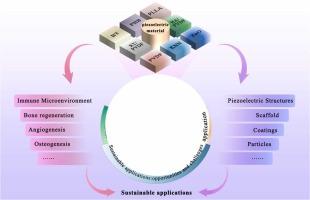Piezoelectric materials for bone implants: Opportunities and challenges
IF 16.8
1区 材料科学
Q1 CHEMISTRY, PHYSICAL
引用次数: 0
Abstract
The rapid advancement of modern medical technology and materials science has facilitated extensive research and application of artificial bone implants for treating bone defects. However, these implants still face challenges such as insufficient osseointegration and bacterial infections, which limit their clinical application. Piezoelectric materials have garnered considerable attention for their potential to promote bone repair and enhance the sustainability of medical applications. In this review, we systematically examine the advances in piezoelectric materials for bone implants. First, the potential of piezoelectric materials in addressing major clinical challenges in bone implantation are discussed. The most commonly used piezoelectric materials in bone implants, including inorganic and organic materials as well as piezoelectric composites, are classified and examined. Subsequently, we explore the various forms of piezoelectric materials used in bone implants, such as particles, coatings, and scaffolds, highlighting their advantages and limitations in improving osseointegration and preventing bacterial infections. Finally, the progress in the clinical application of piezoelectric materials is further analyzed, and both the opportunities and challenges they present in the treatment of bone defects are proposed. Overall, this review systematically examines the advances in piezoelectric materials for bone implants and aims to facilitate the development of novel piezoelectric materials and accelerate the transition of these materials from basic research to clinical application.

求助全文
约1分钟内获得全文
求助全文
来源期刊

Nano Energy
CHEMISTRY, PHYSICAL-NANOSCIENCE & NANOTECHNOLOGY
CiteScore
30.30
自引率
7.40%
发文量
1207
审稿时长
23 days
期刊介绍:
Nano Energy is a multidisciplinary, rapid-publication forum of original peer-reviewed contributions on the science and engineering of nanomaterials and nanodevices used in all forms of energy harvesting, conversion, storage, utilization and policy. Through its mixture of articles, reviews, communications, research news, and information on key developments, Nano Energy provides a comprehensive coverage of this exciting and dynamic field which joins nanoscience and nanotechnology with energy science. The journal is relevant to all those who are interested in nanomaterials solutions to the energy problem.
Nano Energy publishes original experimental and theoretical research on all aspects of energy-related research which utilizes nanomaterials and nanotechnology. Manuscripts of four types are considered: review articles which inform readers of the latest research and advances in energy science; rapid communications which feature exciting research breakthroughs in the field; full-length articles which report comprehensive research developments; and news and opinions which comment on topical issues or express views on the developments in related fields.
 求助内容:
求助内容: 应助结果提醒方式:
应助结果提醒方式:


